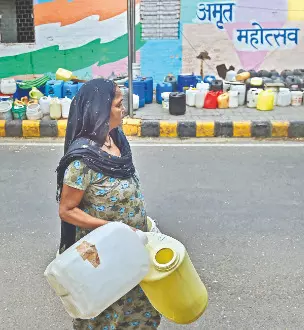Delhi’s poor sacrifice food, schooling for drinking water

New Delhi: In Delhi’s informal settlements, the price of water is quietly eroding the budgets of thousands of families. A new survey by Greenpeace India reveals that nearly one-third of low-income households spend up to 15 per cent of their modest monthly income about Rs.6,000 to Rs.10,000, simply to secure safe drinking water.
The audit, covering 500 households across 12 resettlement colonies and slums, underscores how water scarcity has evolved into an economic burden, forcing the poor to make stark trade-offs. Residents from areas like Sakurpur Basti, Savda Ghevra, Daya Basti, Khajan Basti, Seemapuri, and Sangam Vihar described choosing between water and food, or delaying school fee payments to afford water tankers.
“Water comes here on alternate day basis and living with family with 4 members it is very difficult to manage. Sometimes we have to wait for two days. I spend nearly Rs.2,000 every month on water alone. That’s equal to my daughter’s tuition fees,” said Ramesh Kumar, a resident in Tughlaqabad area. “Sometimes we cut down on vegetables or medicines, but water we cannot live without.”
The report exposes a sharp gap between policy promises and ground realities. Despite the Delhi government’s April 2025 announcement of installing 3,000 water ATMs, only 20 have been operationalised so far, and none in the settlements surveyed. Even in localities with ATMs, residents complain of breakdowns, and irregular supply.
According to a Greenpeace campaigner, the issue is not just technical but systemic. “Water is a basic right, yet for these families it has become an everyday crisis. When ATMs don’t function, people are left to depend on private vendors charging Rs.15–30 per gallon. Heatwaves make
this struggle unbearable.”
The survey reveals that 80 per cent of households faced water shortages between March and July, the hottest months of the year. With 29 per cent relying on Delhi Jal Board (DJB) tankers, 34 per cent on private suppliers, and 21 per cent on ATMs, water procurement itself consumes time and money. A significant 37 per cent of respondents said they lost work hours or school time standing in long
queues for water.
Experts warn that the crisis reflects chronic underinvestment in urban water equity. Dr. Anjali Mehra, an environmentalist said, “Delhi’s water problem is not of absolute scarcity, but of inequitable distribution. Piped water reaches middle-class colonies reliably, while slums are left at the mercy of tankers and vendors. This dual system entrenches inequality.”
For residents, however, it is a lived reality. Shabnam Begum of Sangam Vihar said, “We hear of free schemes on TV, but here we pay every day even to access water. The government must see how we live. We do not expect something big but they should at least fulfill our basic necessity.” The report calls for urgent action, recommending that the Delhi government not only install fully functional water ATMs in underserved areas but also expand access to labour chowks, construction sites, and markets to make water universally accessible.



